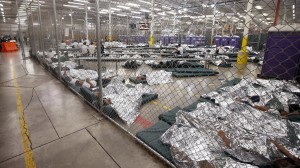L.A. Times Calls Out Congress Over Immigration Court Backlog
Judge Orders Govt. To Release Detained Kids

As reported by NPR: Detainees sleep and watch television in a holding cell where hundreds of mostly Central American immigrant children are being processed at a U.S. Customs facility in Nogales, Texas.
A Year Later: Obama Border Kids Processing Rush Still Claiming Victims
At $3-per-day, immigrants detained by U.S. keep detention centers going
The Los Angeles Times has another story raising questions about how the government goes about detaining would-be immigrants at for-profit detention centers. The report notes that immigrants are allowed to “volunteer” to work, doing chores like landscaping, cleaning and cooking. The reporter talks with a mother who fled Honduras in September with her 11-year-old son and ended up at a family detention center in rural Texas.
“I worked immediately,” the 36-year-old mother said. “In order to have something to eat, to buy treats for my son.” The LAT says the woman “… cleaned bathrooms, hallways and other areas of the government-contracted detention center for $3 a day. At the commissary, a bag of potato chips cost $4, bottled water $2. The facility in Karnes City is run by Geo Group, the country’s second-largest prison company.
“It’s ironic — it’s illegal for them to work, but they’re working for the immigration service in a sense,” says Mark Krikorian, executive director of the Center for Immigration Studies, a conservative think tank in Washington. An ACLU source in the report uses another word for the practice: slavery.
Read the LAT story here.
Federal Judge Ready To Close 3 Immigration Detention Centers
California, Texas Lead In Immigration Court Delays
Report Offers Details About Immigration Court Backlog

As reported in Al Jazeera America: “The nation’s immigration courts got a bit of relief at the beginning of June, when the Department of Justice hired 18 new immigration judges. But the courts are still facing a major backlog.Illustration by Sam Ward for Al Jazeera America”
